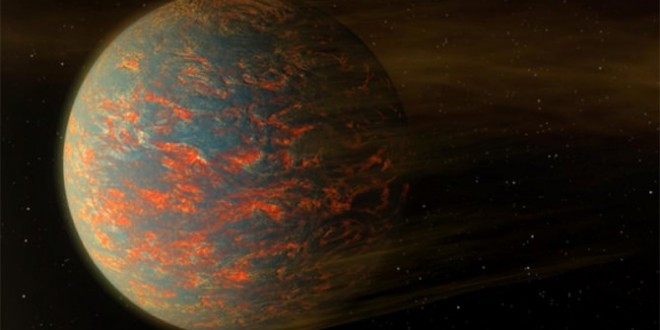Scientists have, for the first time, mapped a nearby “super-Earth” exoplanet to find that one hemisphere is almost completely molten rock, while the other half is almost completely solid.
The super-Earth — which is a classification used for any planet with a mass 1 to 10 times greater than that of our home planet — is named 55 Cancri e and located about 40 light-years away from our solar system.
55 Cancri e is a rocky planet around about twice the size and eight times the mass of Earth. Unlike our planet, however, it orbits its star once every 18 hours. Just like the Moon, this planet is tidally locked, meaning the same side always points towards its star.
Since it’s discovery, 55 Cancri d has been studied extensively. At first, researchers thought it could be made of diamond. Another idea was that it was a water world. Now, by creating a detailed temperature map of the planet, scientists have found it is a ball of lava.
Using temperature data from Nasa’s Spitzer Space Telescope, researchers Nasa and the University of Cambridge were able to create a weather map of the planet – the first time this has ever been done for such a small planet.
Findings, published in the journal Nature, showed the surface of the planet is extremely hot. In addition, they found there are massive temperature changes on it’s two sides. “On the day side, the temperature is around 2,500C, while on the night side it’s about 1,100C,” said Brice-Oliver Demory, lead author of the research. They found an exact difference in temperature of 1,320 degrees Celsius.
Why the two sides are so different is now the subject of debate. Researchers say there are a few reasons why heat is not being transferred between the day and night sides. One is that the day side lacks an atmosphere, having been evaporated by its star. Another, more likely possibility, is that the day side is composed entirely of molten lava, while the dark side is more solid. This means heat is not moved around efficiently.
“The day side could possibly have rivers of lava and big pools of extremely hot magma, but we think the night side would have solidified lava flows like those found in Hawaii,” said researcher Michael Gillon.
Scientists now plan to continue studying 55 Cancri e to learn more about the true nature of the planet: “We haven’t yet found any other planet that is this small and orbits so close to its parent star, and is relatively close to us, so 55 Cancri e offers lots of possibilities,” said Demory. “We still don’t know exactly what this planet is made of – it’s still a riddle. These results are like adding another brick to the wall, but the exact nature of this planet is still not completely understood.”
Agencies/Canadajournal
 Canada Journal – News of the World Articles and videos to bring you the biggest Canadian news stories from across the country every day
Canada Journal – News of the World Articles and videos to bring you the biggest Canadian news stories from across the country every day




Since it’s discovery..
temperature changes on it’s two sides.
Has everybody fired their editors these days?
The super-Earth — which is a classification used for any planet with a mass 1 to 10 times greater than that of our home planet
So if a super-Earth has a mass 1 times the mass of our planet, wouldn’t that make our Earth a super-Earth as well?